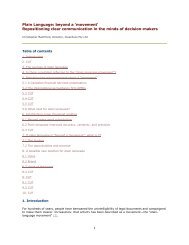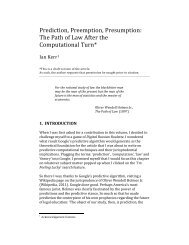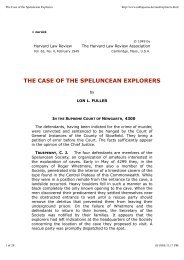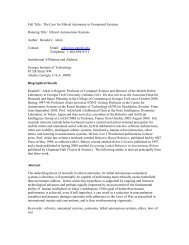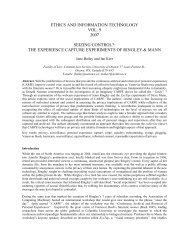'Asimov's Laws of Robotics' - the Laws of Robotics 2013
'Asimov's Laws of Robotics' - the Laws of Robotics 2013
'Asimov's Laws of Robotics' - the Laws of Robotics 2013
- No tags were found...
You also want an ePaper? Increase the reach of your titles
YUMPU automatically turns print PDFs into web optimized ePapers that Google loves.
Roger Clarke's <strong>'Asimov's</strong> <strong>Laws</strong> <strong>of</strong> <strong><strong>Robotics</strong>'</strong><strong>2013</strong>-09-03 10:33 AM* The sheer complexityTo cope with <strong>the</strong> judgmental element in robot decision making, Asimov's later novels introduced a fur<strong>the</strong>rcomplication: "On......[worlds o<strong>the</strong>r than Earth], . . . <strong>the</strong> Third Law is distinctly stronger in comparison to <strong>the</strong>Second Law. . . . An order for self- destruction would be questioned and <strong>the</strong>re would have to be a trulylegitimate reason for it to be carried through - a clear and present danger." 16 And again, "Harm through anactive deed outweighs, in general, harm through passivity - all things being reasonably equal. . . . [A robot is]always to choose truth over nontruth, if <strong>the</strong> harm is roughly equal in both directions. In general, that is."16The laws are not absolutes, and <strong>the</strong>ir force varies with <strong>the</strong> individual machine's programming, <strong>the</strong>circumstances, <strong>the</strong> robot's previous instructions, and its experience. To cope with <strong>the</strong> inevitable logicalcomplexities, a human would require not only a predisposition to rigorous reasoning, and a considerableeducation, but also a great deal <strong>of</strong> concentration and composure. (Alternatively, <strong>of</strong> course, <strong>the</strong> human mayfind it easier to defer to a robot suitably equipped for fuzzy- reasoning- based judgment.)The strategies as well as <strong>the</strong> environmental variables involve complexity. "You must not think . . . thatrobotic response is a simple yes or no, up or down, in or out. ... There is <strong>the</strong> matter <strong>of</strong> speed <strong>of</strong> response."16In some cases (for example, when a human must be physically restrained), <strong>the</strong> degree <strong>of</strong> strength to beapplied must also be chosen.* The scope for dilemma and deadlockA deadlock problem was <strong>the</strong> key feature <strong>of</strong> <strong>the</strong> short story in which Asimov first introduced <strong>the</strong> laws. Heconstructed <strong>the</strong> type <strong>of</strong> stand- <strong>of</strong>f commonly referred to as <strong>the</strong> "Buridan's ass" problem. It involved a balancebetween a strong third- law self- protection tendency, causing <strong>the</strong> robot to try to avoid a source <strong>of</strong> danger, anda weak second- law order to approach that danger. "The conflict between <strong>the</strong> various rules is [meant to be]ironed out by <strong>the</strong> different positronic potentials in <strong>the</strong> brain," but in this case <strong>the</strong> robot "follows a circlearound [<strong>the</strong> source <strong>of</strong> danger], staying on <strong>the</strong> locus <strong>of</strong> all points <strong>of</strong> ... equilibrium." 5Deadlock is also possible within a single law. An example under <strong>the</strong> first law would be two humansthreatened with equal danger and <strong>the</strong> robot unable to contrive a strategy to protect one without sacrificing <strong>the</strong>o<strong>the</strong>r. Under <strong>the</strong> second law, two humans might give contradictory orders <strong>of</strong> equivalent force. The laternovels address this question with greater sophistication:What was troubling <strong>the</strong> robot was what roboticists called an equipotential <strong>of</strong> contradiction on<strong>the</strong> second level. Obedience was <strong>the</strong> Second Law and [<strong>the</strong> robot] was suffering from two roughlyequal and contradictory orders. Robot- block was what <strong>the</strong> general population called it or, morefrequently, roblock for short . . . [or] `mental freeze- out.' No matter how subtle and intricate abrain might be, <strong>the</strong>re is always some way <strong>of</strong> setting up a contradiction. This is a fundamentaltruth <strong>of</strong> ma<strong>the</strong>matics. 16Clearly, robots subject to such laws need to be programmed to recognize deadlock and ei<strong>the</strong>r choosearbitrarily among <strong>the</strong> alternative strategies or arbitrarily modify an arbitrarily chosen strategy variable (say,move a short distance in any direction) and reevaluate <strong>the</strong> situation: "If A and not- A are precisely equalmisery- producers according to his judgment, he chooses one or <strong>the</strong> o<strong>the</strong>r in a completely unpredictable wayand <strong>the</strong>n follows that unquestioningly. He does not go into mental freeze- out."16http://www.rogerclarke.com/SOS/Asimov.htmlPage 10 <strong>of</strong> 30



